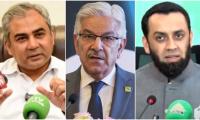LAHORE: No major breakthrough was made in Pakistan-India trade in 2015 as the same issues that impeded trade during the past three decades remained unresolved.
The tariff and non-tariff trade barriers are stubbornly defended by both India and Pakistan, more so by the Indians where bureaucratic barriers slow clearance of Pakistani goods and increase the cost.
It is true that India granted MFN status to Pakistan two decades back but the Indian market remains restrictive to Pakistani goods. Firstly, India has large number of agriculture and textile tariff lines that are in its sensitive list. Secondly, India’s preferential trade agreements with Bangladesh and Sri Lanka undermine greater market access to Pakistani textiles. The non-tariff barriers are in addition to these drawbacks.
The Bureau of Indian Standards is to be complied with for products like cement. This certification is very expensive and has only 1 year validity. Officially the renewal certificate has to be granted in 3-4 weeks but practically it takes six months for Pakistani companies. This barrier has been pointed out repeatedly over the last decade but it remained in force in 2015 resulting in sharp decline in Pakistan’s cement exports to India.
At the bureaucratic end the security check of Pakistani goods causes undue delay in clearance of goods. Both countries are committed to open bank branches in each other’s territory since 2008 but nothing practically has been done in this regard, though there was again a mutual in the middle of 2015 to expedite opening of bank branches. Currently payments made through international bank or informal channels increase transaction cost. The absence of adequate warehousing and cold storage at border posts on both sides is another trade barrier that remained unresolved this year.
Fabric exporters from Pakistan complain that their consignments are subjected to SGS and OEKOTEX testing and certification which besides being expensive delays release of goods. The Indian planners during their talks with Pakistani counterparts have assured many times that they would accept internationally accredited certification but the issue still exists. Finished leather exporters in addition to SGS also require certification from the Veterinary Department of India.
Pakistan has also imposed some trade barriers but those are very mild when compared with Indian trade barriers. This can be judged by the barometer of the intensity of the trade restrictiveness through NTBs and other measures that is called trade restrictiveness index (OTRI) prepared by the World Bank.
This index is based on tariffs and NTB’s imposed by a country. India’s ORTI is 46.7 which are highest in South Asia. The trade restrictiveness in this score is dominated by NTBs which accounts for 24.5 percent of the index value. Pakistan’s OTRI is 22.2, which is less than half of India. In this the NTBs accounts for only 5.1 percent of the index value which is almost four times less than India. In addition, travel bans and suspension of trade routes discourage Pakistani firms to develop supply lines in India. No progress was made in this regard during this year.
If we look at the chronology of trade related events in 2015, the year started on a very promising note when the Federal Commerce Minister Ghulam Dastigir in a statement on February 6, 2015 suggested that Pakistan may grant “Non-discriminatory market access” (NDMA) to India. Only two days later on February 8, the Indian authorities seized 12 kilograms of opium from a Pakistani Kashmir truck carrying oranges to Indian Kashmir on line of control. Following this seizure even the Kashmir-Kashmir trade was suspended immediately and was resumed two days later. This suspension of trade was in line with the Indian behaviour that cuts trade ties on any event. These episodes also occur in other parts of the world but the authorities strengthen their control instead of cutting trade ties.
Indian High Commissioner in Pakistan TCA Raghavan, in his address to the businessmen at the Lahore Chamber of Commerce and Industry (LCCI) on February 20, expressed the hope that the two countries could become growth opportunities for each other. Similar sentiments were expressed by his Pakistani counterpart Abdul Basit in India. These statements gave a ray of hope that the trade ties would improve. Pakistan on May 3, denied Indian request to allow to carry out trade with Afghanistan through the Wagah Border, and instead suggested that trade with Kabul could be conducted via the Karachi port. The next six months saw stalemate in Pak-India talks, and the trade facilitation process was also halted.
The change in heart occurred in December this year when the Indian foreign Minister visited Pakistan, promising to carry on all talks, including Kashmir and trade without further interruption. The expectations are high this time perhaps because India now sees that China-Pakistan Economic Corridor is a reality and it would need this corridor to conduct trade with China, Afghanistan, and Central Asian States.
Experts suggest that since the grant of MFN status to India has not paid any dividend to Pakistan there is a need to review the way the two countries want to conduct trade with each other. The Indian trade policy is designed with an intention to discourage imports from the neighbouring countries that produce similar products which are produced in India. It was for this reason that the import duties of many items were kept flexible by stating that the duty on certain items will be 10 percent or Rs150 per square yard whichever is higher. We can take the case of fabric where Pakistani fabric on average costs $1-1.5 per square yard. This means 69-90 Indian rupees. It would not qualify for 10 percent duty regime and will be cleared on payment of Rs150 duty that is more than 150 percent of the imported price of Pakistani fabric. The high quality fabric from Italy would cost $7-10 or more. It will be cleared at 10 percent duty that would be higher than Rs150.
There are various instances of similar nature in Indian trade regime. Pakistan would have to sign a bilateral trade pact with India in which Pakistan either matches the duties and NTBs erected by Indians, or we come at a viable solution where products from each country have fair and unbiased access.
If we look at the history of Pak-India trade, Pakistan restricted negative list of items to 1,209 items out of over 8,000 items that could be imported to India.
In 1947 the trade between the two countries was conducted without barriers. The trade volume with India was almost 70 percent and heavily in the favour of Pakistan. The trade was suspended during 1948-1949, armed conflict in Kashmir. After resumption Pakistan’s export to India reached US $113 million in 1951 against imports of $0.08 million from India. The slow trickling of trade after war was again stopped due to 1971 Indo-Pak war. Pakistan signed a bilateral trade agreement for three years with India in 1975. It was not renewed after expiry in 1978. Balance of trade between the two countries remained in Pakistan favour until 1993. The trade balance then continued tilting in favour of India.
By Tariq Ahmed Saeedi
KARACHI: Pakistan’s cash-dominant society will see a new wave of digital transformation in the New Year as technology-oriented businesses are relentless in their efforts to gear 35 million and growing internet-connected population to electronic payment mode.
But, industry observers see a gravest devoid of teamwork in the digital ecosystem.
The most happening launch in 2016 will be from a Fintech (financial technology startup), which is seen as a digital disruption by financial institutions, when it’ll roll out its mobile wallet – a maiden partnership between Fintech and a microfinance bank.
FinSurgents is allying with FINCA Microfinance Bank Ltd to offer mobile payment solution, its founder Qasif Shahid told The News.
Market sources said Bank Alfalah is also going to introduce its epayment gateway next year to cash in on the opportunities offered from internet shopping.
Further, Telenor Pakistan, which is already running its digital payment service Easypay, is making headways to bring this at par with the international standards by integrating an Escrow platform.
With Escrow – a temporary account held by the third party – a shopper can withhold payment release until s/he receives a product in line with the shopper’s expectation.
Strategist Omar Moeen Malik at Easypaisa, Telenor Pakistan said the service will be in the market by the first quarter of the next year.
The future is full of happenings for the internet payment, but the present is just a little step forward from the past.
Digital payments still account for much less than one percent of all the transactions taking place in the cyber world of Pakistan as payers mainly rely on cash to shop products and avail services.
The biggest reason is the absence of well-structured, coordinated and perhaps independently operating epayment gateway, much like 2Checkout, Authorize.net or PayPal.
Adam Dawood, managing director at Kaymu.com said an epayment gateway needs lots of collaborations.
Dawood said internet speed and security are as much important, but “2016 can be an important year for online payment solutions.”
“Now, it depends on how much the system is secured and safe,” he said.
Irfan Qureshi, who heads new initiatives of payment systems group at HBL, said the epayment system needs to meet the international standards. “Card numbers [of a payer] should not be saved on the website.”
Early this year, the central bank issued guidelines for the acquisition of payment system operator/payment service provider (PSO/PSP) licence.
The sources said the State Bank of Pakistan got a poor response as little interest was expressed in getting licence to start an epayment gateway – e-commerce application service provider authorising internet payment from an online shopper and acting as a middle platform between an acquiring bank and the electronic seller.
The central bank could not confirm this.
Payment consultant Faisal Khan said the licence fee is Rs200 million, “which is very huge.”
“Another at least Rs50 million is required to set up a sophisticated infrastructure,” Khan said.
HBL, MCB and UBL are facilitating digital payments through credit and debit cards of Visa and Master. Payment network Keenu facilitates online payment through IBFT (interbank fund transfer). But, they are plastic card acquirers and not epayment gateways.
Sometimes, however, it becomes a hassle for a digital payer to take permission first from the bank to make online payment through the plastic card.
“This increases the bounce rate as a shopper prefers a substitute over a wait for an approval,” Khan said.
Even if plastic money is allowed it will still be used by a small population.
There are 1.3 million credit cards and every card holder has an average two to three cards so unique numbers of cards is 700,000. The number of debit cards is little over 25 million.
“Financial inclusion is low,” Dawood said. “But, mobile wallet is a game changer.”
There are at least 130 million biometric verified mobile phone users, while smartphone users have crossed the mark of 25 million. Nauman Sikandar of EatOye said mobile wallet use is more penetrative in rural than urban areas.
Right now, a customer has to open an account with a particular bank leading mobile payment of a telecom operator, and then has to deposit funds into that before making a mobile payment.
Over the counter payment allowed to a noncustomer through the agent network of a telecom company takes off the convenience of online shopping, as a customer has to go out of his/her place of comfort for this.
Similarly, a Telenor customer is not allowed to transfer money to Ufone’s subscriber.
“Interoperability will be wonderful,” said Sikandar, who’s EatOye was acquired, early this year, by Foodpanda, a concern of Berlin-based Rocket Internet.
“There needs to be cooperation among all the stakeholders.” Industry experts said there is a lack of trust. “Banks should be accommodative,” Shahid said. “Right now there is a long procedure for qualifying as a merchant.”
Ecommerce players are mushrooming in Pakistan, but there is no regulatory body to keep check on deception of a buyer and an e-retailer falling short on commitment.
“Rules and regulations should be defined,” Malik said.
Chief Executive Officer Ali Aziz at ecommerce enabler Shopistan said the system technology is immature.
Malik agreed that Pakistan is far behind when compared with modern internet payment structures operating in the developed world.
Khan said everyone has to sit together for a consensus. He put weight behind the argument that the tax structure for customer and merchants is impeding the growth of ecommerce in the country.
Shoppers should be incentivised to move away from cash transactions. And, “volumes can be increased 10 times in the next two years,” Qureshi said.
A worker checks a vehicle at a workshop. — AFP/FileKARACHI: During the three-day Automotive Aftermarket Products...
Gold bars from the vault of a bank are seen in this illustration picture taken in Zurich, Switzerland, on November 20,...
The IMF’s logo can be seen at its headquarters. — AFP/FileCOLOMBO: The International Monetary Fund approved the...
CEO of Nvidia Jensen Huang speaks after receiving an honorary degree from Hong Kong University of Science and...
People throng a market area in Lahore. — AFP/FileLAHORE: The survival of Pakistan despite decades of corruption,...
Cyril Ramaphosa Chinese President Xi Jinping, and Australian Prime Minister Anthony Albanese pose with other G20...







